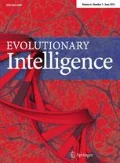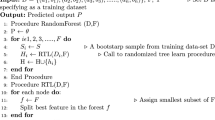Abstract
Recently machine learning algorithms are widely used for the prediction of different attributes, and these algorithms find widespread applications in a variety of domains. Machine learning in health care has been one of the core areas of research where machine learning models are used on the medical datasets to predict different attributes. This work provides a comparative evaluation of different classical as well as ensemble machine learning models, which are used to predict the risk of diabetes from two different datasets, i.e., PIMA Indian diabetes dataset and early-stage diabetes risk prediction dataset. From the comparative analysis, it is found that the superlearner model provides the best accuracy i.e. 86% for PIMA Indian diabetes dataset, and it provides 97% accuracy for diabetes risk prediction dataset.

















Similar content being viewed by others
References
Fayyad U, Piatetsky-Shapiro G, Smyth P (1996) From data mining to knowledge discovery in databases. AI Mag 17(3):37–37
Yang J, Li Y, Liu Q, Li L, Feng A, Wang T, Zheng S, Anding X, Lyu J (2020) Brief introduction of medical database and data mining technology in big data era. J Evid Based Med 13(1):57–69
Shadi A, Aurea A, Atwood JW, Lara JA, Lizcano D (2019) Particularities of data mining in medicine: lessons learned from patient medical time series data analysis. EURASIP J Wirel Commun Netw 1:260
Bellazzi R, Zupan B (2008) Predictive data mining in clinical medicine: current issues and guidelines. Int J Med Inf 77(2):81–97
Bellazzi R, Ferrazzi F, Sacchi L (2011) Predictive data mining in clinical medicine: a focus on selected methods and applications. Wiley Interdiscip Rev Data Min Knowl Discov 1(5):416–430
Parva E, Boostani R, Ghahramani Z, Paydar S (2017) The necessity of data mining in clinical emergency medicine; a narrative review of the current literatrue. Bull Emerg Trauma 5(2):90
Dirar AHM, Doupis J (2017) Gestational diabetes from a to z. World J Diabetes 8(12):489
Ramachandran A, Snehalatha C, Shyamala P, Vijay V, Viswanathan M (1994) Prevalence of diabetes in pregnant women-a study from southern india. Diabetes Res Clin Pract 25(1):71–74
Mishra M, Nayak J, Naik B, Abraham A (2020) Deep learning in electrical utility industry: a comprehensive review of a decade of research. Eng Appl Artif Intell 96:104000
Kotsiantis SB, Zaharakis ID, Pintelas PE (2006) Machine learning: a review of classification and combining techniques. Artif Intell Rev 26(3):159–190
Kavakiotis I, Tsave O, Salifoglou A, Maglaveras N, Vlahavas I, Chouvarda I (2017) Machine learning and data mining methods in diabetes research. Comput Struct Biotechnol J 15:104–116
Larabi-Marie-Sainte S, Aburahmah L, Almohaini R, Saba T (2019) Current techniques for diabetes prediction: review and case study. Appl Sci 9(21):4604
Elhadd T, Mall R, Bashir M, Palotti J, Fernandez-Luque L, Farooq F, Al Mohanadi D, Dabbous Z, Malik RA, Abou-Samra AB (2020). Artificial intelligence (AI) based machine learning models predict glucose variability and hypoglycaemia risk in patients with type 2 diabetes on a multiple drug regimen who fast during ramadan (the profast–it ramadan study). Diabetes Res Clin Pract
Zarkogianni K, Athanasiou M, Thanopoulou AC, Nikita KS (2017) Comparison of machine learning approaches toward assessing the risk of developing cardiovascular disease as a long-term diabetes complication. IEEE J Biomed Health Inf 22(5):1637–1647
Han W, Yang S, Huang Z, He J, Wang X (2018) Type 2 diabetes mellitus prediction model based on data mining. Inf Med Unlocked 10:100–107
Alkhasawneh MS (2019) Hybrid cascade forward neural network with elman neural network for disease prediction. Arab J Sci Eng 44(11):9209–9220
Guo Y, Bai G, Hu Y (2012) Using bayes network for prediction of type-2 diabetes. In: 2012 International conference for internet technology and secured transactions, pp 471–472. IEEE
Rahman M, Islam D, Mukti RJ, Saha I (2020) A deep learning approach based on convolutional LSTM for detecting diabetes. Comput Biol Chem 88:107329
Xia Y, Chen K, Yang Y (2021) Multi-label classification with weighted classifier selection and stacked ensemble. Inf Sci 557:421–442
Mohapatra D, Subudhi B (2020) Weighted majority rule ensemble classifier for sensor fault classification for plasma position control in tokamaks. Fusion Eng Des 160:111969
Moyano JM, Gibaja EL, Cios KJ, Ventura S (2018) Review of ensembles of multi-label classifiers: models, experimental study and prospects. Inf Fus 44:33–45
Pari R, Sandhya M, Sankar S (2018) A multitier stacked ensemble algorithm for improving classification accuracy. Comput Sci Eng 22(4):74–85
Graczyk M, Lasota T, Trawiński B, Trawiński K (2010) Comparison of bagging, boosting and stacking ensembles applied to real estate appraisal. In: Asian conference on intelligent information and database systems. Springer, pp 340–350
Hasan MK, Alam MA, Das D, Hossain E, Hasan M (2020) Diabetes prediction using ensembling of different machine learning classifiers. IEEE Access 8:76516–76531
https://www.kaggle.com/uciml/pima-indians-diabetes-database. Online; accessed 08-Jun-2021
https://www.kaggle.com/ishandutta/early-stage-diabetes-risk-prediction-dataset. Online; accessed 02-Aug-2021
Friedman L, Komogortsev OV (2019) Assessment of the effectiveness of seven biometric feature normalization techniques. IEEE Trans Inf Forensics Secur 14(10):2528–2536
Jo J-M (2019) Effectiveness of normalization pre-processing of big data to the machine learning performance. J Korea Inst Electron Commun Sci 14(3):547–552
Ben-Gal I (2005) Outlier detection. Data mining and knowledge discovery handbook. Springer, pp 131–146
Hodge V, Austin J (2004) A survey of outlier detection methodologies. Artif Intell Rev 22(2):85–126
Wang H, Bah MJ, Hammad M (2019) Progress in outlier detection techniques: a survey. IEEE Access 7:107964–108000
Nnamoko N, Korkontzelos I (2020) Efficient treatment of outliers and class imbalance for diabetes prediction. Artif Intell Med 104:101815
Hemphill E, Lindsay J, Lee C, Măndoiu II, Nelson CE (2014) Feature selection and classifier performance on diverse bio-logical datasets. volume 15, p S4. Springer, Springer Science and Business Media LLC
Tuv E, Borisov A, Runger G, Torkkola K (2009) Feature selection with ensembles, artificial variables, and redundancy elimination. J Mach Learn Res 10:1341–1366
Kamkar I, Gupta SK, Phung D, Venkatesh S (2015) Stable feature selection for clinical prediction: exploiting ICD tree structure using Tree-Lasso. J Biomed Inf 53:277–290
Arlot S, Celisse A et al (2010) A survey of cross-validation procedures for model selection. Stat Surv 4:40–79
Ng AY, Jordan MI (2002) On discriminative vs. generative classifiers: a comparison of logistic regression and naive bayes. In: Advances in neural information processing systems, pp 841–848
Merghadi A, Yunus AP, Dou J, Whiteley J, ThaiPham B, Bui DT, Avtar R, Abderrahmane B(2020) Machine learning methods for landslide susceptibility studies: a comparative overview of algorithm performance. Earth Sci Rev, p 103225
Bergstra J, Bengio Y (2012) Random search for hyper-parameter optimization. J Mach Learn Res 13(1):281–305
Pradeep Kandhasamy J, Balamurali SJPCS (2015) Performance analysis of classifier models to predict diabetes mellitus. Procedia Comput Sci 47:45–51
Yuvaraj N, SriPreethaa KR (2019) Diabetes prediction in healthcare systems using machine learning algorithms on hadoop cluster. Clust Comput 22(1):1–9
Anuja Kumari V, Chitra R (2013) Classification of diabetes disease using support vector machine. Int J Eng Res Appl 3(2):1797–1801
Author information
Authors and Affiliations
Corresponding author
Ethics declarations
Conflict of interest
The authors declare that they have no conflict of interest.
Additional information
Publisher's Note
Springer Nature remains neutral with regard to jurisdictional claims in published maps and institutional affiliations.
Rights and permissions
About this article
Cite this article
Saxena, S., Mohapatra, D., Padhee, S. et al. Machine learning algorithms for diabetes detection: a comparative evaluation of performance of algorithms. Evol. Intel. 16, 587–603 (2023). https://doi.org/10.1007/s12065-021-00685-9
Received:
Revised:
Accepted:
Published:
Issue Date:
DOI: https://doi.org/10.1007/s12065-021-00685-9




